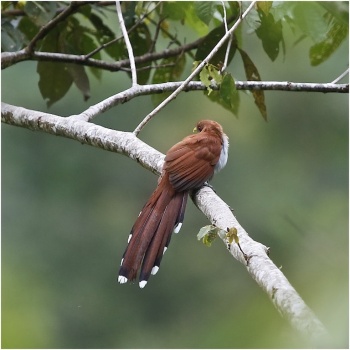- Piaya cayana
Identification
43-46cm (17-18 in)
- upperparts and head chestnut (paler on the throat)
- lower breast grey
- belly black
- uppertail white-tipped chestnut
- undertail black and white banded due to broad white tail feather tips
- bill and bare eyering are yellow
- iris red
Immature birds: grey bill and eyering, brown iris, and less white in the tail.
Distribution
Central and South America
Central America: Mexico, Guatemala, Belize, El Salvador, Honduras, Nicaragua, Costa Rica, Trinidad
South America: Colombia, Venezuela, Guyana, Suriname, French Guiana, Ecuador, Peru, Bolivia, Brazil, Paraguay, Uruguay, Argentina
Taxonomy
Subspecies
Fourteen subspecies share the rather large range[1]:
- P. c. mexicana: Pacific slope of Mexico (Sinaloa to Isthmus of Tehuántepec)
- P. c. thermophila: Eastern Mexico to eastern Panama, north-western Colombia and offshore islands
- P. c. nigricrissa: Western Colombia and western Ecuador to central Peru
- P. c. mehleri: North-eastern Colombia and coastal northern Venezuela east to Paría Peninsula
- P. c. mesura: Colombia east of the Andes and eastern Ecuador
- P. c. circe: Western Venezuela (region south of Lake Maracaibo)
- P. c. cayana: Orinoco Valley of Venezuela to the Guianas and northern Brazil
- P. c. insulana: Trinidad
- P. c. obscura: Brazil south of the Amazon (Rio Juruá to Rio Tapajós)
- P. c. hellmayri: Brazil south of the Amazon (Santarém to Amazon delta)
- P. c. pallescens: Eastern Brazil (Piauí, Pernambuco, northern Bahia and adjacent eastern Goiás)
- P. c. cabanisi: South-central Brazil (central Mato Grosso and adjacent Goiás)
- P. c. macroura: South-eastern Brazil to Paraguay, Uruguay and north-eastern Argentina
- P. c. mogenseni: Southern Bolivia and adjacent north-western Argentina
Habitat
Open types of forest and woodland, canopy and edges, second growth, hedges and semi-open habitats.
Behaviour
It gets its English name from its squirrel-like way of running along tree branches and leaping from branch to branch without using its wings.
Diet
The diet consists of insects, cicadas, wasps and caterpillars (including poisonous ones), spiders and small lizards.
Breeding
They are not brood parasites.
They build a cup-shaped nest of leaves. The clutch consists of 2 to 3 white eggs which are incubated by both parents.
References
- Clements, J. F., T. S. Schulenberg, M. J. Iliff, D. Roberson, T. A. Fredericks, B. L. Sullivan, and C. L. Wood. 2017. The eBird/Clements checklist of birds of the world: v2017, with updates to August 2017. Downloaded from http://www.birds.cornell.edu/clementschecklist/download/
- Avibase
- Wikipedia
- Handbook of the Birds of the World Alive (retrieved June 2018)
Recommended Citation
- BirdForum Opus contributors. (2025) Squirrel Cuckoo. In: BirdForum, the forum for wild birds and birding. Retrieved 18 May 2025 from https://www.birdforum.net/opus/Squirrel_Cuckoo
External Links
GSearch checked for 2020 platform.1








